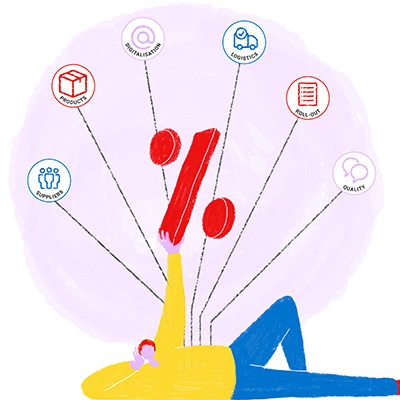The wave of technological revolution is carrying companies along as they increasingly digitalise. The procurement function is no exception. The implementation of e-procurement in Europe continues to grow, as confirmed by the fifth Digital Procurement survey conducted by PwC in 2024. But let's delve deeper into the electronic procurement situation. What is the state of procurement digitalisation in Europe? What are the prospects for the coming years? And what are the priorities for the digitalisation of procurement to overcome this challenge?
What's the state of e-procurement in Europe?
Also known as "electronic procurement" or "procurement digitalisation", e-procurement is increasingly developing in the B2B world. Where does Europe stand in this transition? What are the objectives of European companies?
A favourable context for e-procurement on a global scale
All continents have begun their transformation towards e-procurement systems. Europe takes the top spot on the podium with 41% of digitalised processes, followed by Asia-Oceania (39%) and America (38%).
Recent crises (economic, geopolitical, environmental...) have highlighted the strategic role of the procurement function for company sustainability. In this context, the use of e-procurement proves to be a formidable lever for performance.
Through their digital systems, procurement departments want to obtain tangible gains, whether in terms of reporting, operational efficiency, or regulatory compliance. In this context, the integration of e-procurement has accelerated considerably in recent years.
The state of e-procurement in Europe
European companies aim to increase from 41% of current digitalised processes to 69% by 2027. Today, Procure-to-Pay (P2P) and Source-to-Contract (S2P) solutions have become the norm within organisations. 96% and 92% of companies respectively are equipped with these. The majority are implementing market solutions rather than internally developed ones.
To date, only 5% of companies do not use any software solution and stick to traditional procurement. This figure has halved compared to 2022, uniformly across all types of companies.
In the report, the Digital Procurement Transformation Director at PwC emphasises: "To achieve a higher level of digitalisation, companies must focus on the following areas: the number of deployments and completion of digitalisation projects, the level of automation by improving solutions and processes, and the adoption rate by optimising and facilitating the use of solutions."
Procurement digitalisation in Europe: the priorities
Procurement departments are temporarily putting innovation and talent management on the back burner in favour of short-term strategic priorities. Here's an overview of the five main motivations for European companies to overcome the challenges of e-procurement.
1 - Financial performance
As Europe faces a global price increase, wanting to reduce costs seems self-evident. It's not surprising to see this objective persist as the number one priority since 2019. In addition to inflation-related difficulties, there are issues of declining activity and labour shortages in certain sectors. These are all additional arguments in favour of a cost-reduction strategy for companies.
2 - Digital transformation
While digital transformation previously concerned mainly large companies, small and medium-sized enterprises are now accelerating their transition and planning a much larger investment to successfully carry out their digitalisation. A positive ROI is thus emerging for them in the short, medium and long term. To initiate this transformation in a sustainable way and feel immediate effectiveness, it's preferable to focus on the least complex procurement processes.
3 - Supplier sourcing
Supplier sourcing represents only 12% of European companies' priorities, but it still comes in third place behind financial performance and digital transformation. With a desire for sustainable development, transparency and differentiation from the competition, procurement departments are making it a point of honour to select quality suppliers who share their commitments. The strategic sourcing of suppliers, through the electronic management of tenders, is one of the pillars of the procurement function that allows, among other things, to increase margins and reduce risks.
4 - Corporate Social Responsibility
In fourth priority is a growing topic for the procurement function: CSR. This shows that buyers are positioning themselves as key players in addressing growing business and regulatory challenges driven by the European Commission (CSRD, CS3D...) that impact suppliers. On their roadmap, procurement departments have notably integrated monitoring of greenhouse gas emissions, traceability of purchases, and data transparency.
5 - Supplier relationship management
Lastly, supplier relationship management ranks fifth. Companies want to simplify their relationships with suppliers through SRM (Supplier Relationship Management) solutions. The idea is to gain visibility on the performance of their partners and in risk management, while improving collaboration on key issues such as supply continuity, CSR regulations...
Procurement digitalisation: transformations to come
Tomorrow's procurement goes through digitalisation, a source of many advantages that allow buyers to be even more efficient.
Continuous investments
Since 2020, each company type has maintained the same level of investment. For their part, SMEs and mid-sized companies continue to accelerate their investments. While they need to invest more per user, their size allows them to quickly convert investments into business value.
On the other hand, large and very large companies tend to stabilise their investments. With a higher level of digitalisation, they benefit from economies of scale on the level of investment per user.
The roadmap for the next three years
Data analysis and Source-to-Contract are the main use cases planned by the procurement function to gain performance.
For its part, Procure-to-Pay remains in the top 5 but records a sharp decline due to the fact that most companies are already equipped with P2P tools. On the contrary, we observe two subjects in significant progression: risk management and prevention, as well as monitoring of CO2 emissions, particularly scope 3.
Lastly, new use cases are emerging: contract management (through creation to end), increasing regulations on invoice dematerialisation within the European Union and elsewhere, and the use of generative AI.








